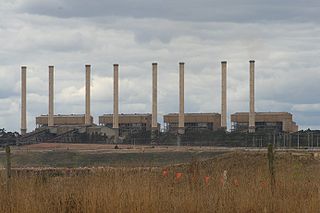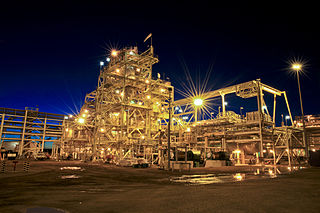Related Research Articles
Mine closure planning involves planning effectively for the after-mining landscape – all activities required before, during, and after the operating life of a mine that are needed to produce an acceptable landscape economically. Closure performance refers to the activities near and after mine closure and how well activities listed in the closure plan are carried out.

The TauTona Mine, formerly Western Deep Levels No.3 Shaft, is a gold mine located in the West Wits gold field west of Johannesburg. The mine is near the town of Carletonville in South Africa. At approximately 3.9 kilometers (2.4 mi) deep, it is home to the world's second deepest mining operation, rivalled only by the Mponeng Gold Mine, formerly Western Deep Levels No.1 Shaft. TauTona was temporarily closed in 2018.

The Hazelwood Power Station was a decommissioned brown coal-fuelled thermal power station located in the Latrobe Valley of Victoria, Australia. Built between 1964 and 1971, the 1,600-megawatt-capacity power station was made up of eight 200MW units, and supplied up to 25% of Victoria's base load electricity and more than 5% of Australia's total electricity demand. It was a 'subcritical' pulverized coal-fired boiler. The station was listed as the least carbon efficient power station in the OECD in a 2005 report by WWF Australia, making it one of the most polluting power stations in the world. At 1.56 tonnes of CO2 for each megawatt hour of electricity, it was 50% more polluting than the average black coal power station in New South Wales or Queensland. Hazelwood emitted 14% of Victoria's annual greenhouse gas emissions and 3% of Australia's greenhouse gas emissions.

Energy Resources of Australia Ltd is a public company based in Australia. It is a subsidiary of the Rio Tinto Group which as of 2021 owns 86.3% of the company. The remainder is publicly held and traded on the Australian Securities Exchange. The chairman is Peter McMahon and Chief Executive is Andrea Sutton.
The Timbarra Gold Mine was a highly controversial gold mine located on the Timbarra Plateau, at the head waters of the Clarence River, near Tenterfield, New South Wales, Australia. The gold ore body consisted of a greisen type granite. The protracted controversy attracted national and international attention, and catalysed an anti-cyanide extraction campaign in Australia.
Melba Flats is a railway siding on the Emu Bay Railway east of Zeehan that served as a terminus for trains carrying copper ore from the Mount Lyell Mining and Railway Company in west coast Tasmania, once the Emu Bay Railway ceased services into the Zeehan townsite.

The Mining industry of Ghana accounts for 5% of the country's GDP and minerals make up 37% of total exports. Gold contributes over 90% of the total mineral exports. Thus, the main focus of Ghana's mining and minerals development industry remains focused on gold. Ghana is Africa's largest gold producer, producing 80.5 t in 2008. Ghana is also a major producer of bauxite, manganese and diamonds. Ghana has 20 large-scale mining companies producing gold, diamonds, bauxite and manganese; over 300 registered small scale mining groups; and 90 mine support service companies. Other mineral commodities produced in the country are natural gas, petroleum, salt, and silver.
Rosslyn Hill Mining Pty Ltd operates Paroo Station Mine at Wiluna in Western Australia.

The Ministry of Mines is the ministry in the Government of India. The ministry functions as the primary body for the formulation and administration of laws relating to mines in India. The head of the ministry is G. Kishan Reddy, who has been serving since June 2024.
The Paulsens Gold Mine is a gold mine located 105 km south of Pannawonica, Western Australia, within the pastoral lease of the Mount Stuart Station. It is fully owned by Black Cat Syndicate, having purchased the mine from Northern Star Resources in June 2022. Production at the mine was halted in December 2017 and is currently in care and maintenance.
The Coyote Gold Mine is a gold mine located in the remote Tanami Desert in the Kimberley region of Western Australia. The mine, processing plant and camp are 17 km west of the Northern Territory border. The mine was closed in 2013 and placed on care and maintenance.
The Sandstone Gold Mine is a gold mine located 6 km south east of Sandstone, Western Australia.
The Coolgardie Gold Mine is a gold mine located at Coolgardie, Western Australia, currently owned by Focus Minerals Limited. The mine and its Three Mile Hill Processing Plant has been in care and maintenance since June 2013.
The Obuasi Gold Mine is an underground gold mine situated near Obuasi, in the Ashanti Region of Ghana. It was at one time one of the world's ten largest gold mines. The mine is in Obuasi Municipal District, 60 kilometres (37 mi) southwest of the regional capital Kumasi.

The Ravensthorpe Nickel Mine is a nickel mine and hydrometallurgical processing plant located at Bandalup Hill, 35 km (22 mi) east of Ravensthorpe, Western Australia.

The Hill 50 Gold Mine, now referred to as the Mount Magnet Gold Mine, is a gold mine located 4 km north-west of Mount Magnet, Western Australia. The mine was, until July 2010, owned by Harmony Gold and had been placed in care and maintenance since 2007. In July 2010, Harmony sold the mine to Ramelius Resources, owner of the Wattle Dam Gold Mine, for A$40 million.
The Canatuan mine was a gold/silver, copper/zinc open-pit mine located in the province of Zamboanga del Norte on the southern island of Mindanao, Philippines. The mine was operated from 2004 to January 2014 by TVI Resource Development (Phils) Inc., a former subsidiary of Canadian-based TVI Pacific Inc. The mine was operated within Mount Canatuan, a sacred mountain of the Subanen people, who protested against the mining company and its operations.
Layne Christensen Company is a U.S.-based global water management, construction and drilling company. The company has two divisions, which are Water Resources-Mineral Services and Inline.

Nickel mining in Western Australia has been an industry that has had many fluctuations of fortune in its history. Large fluctuations in the world nickel price have seen mines close and reopen on several occasions.
Mark Gareth Creasy is a Western Australian mining entrepreneur.
References
- ↑ "New Gold Places the Amapari Mine on Temporary Care and Maintenance", The America's Intelligence Wire, Financial Times Ltd, 2009-01-02, retrieved 30 October 2012
- ↑ "Rayrock Yellowknife Resources Inc. to put Dee Mine on care and maintenance basis", Business Wire: 2140086, 1997-02-14, retrieved 30 October 2012
- ↑ "First Nickel Places Lockerby Mine on Care and Maintenance", Canadian Corporate News, COMTEX News Network, Inc, 2008-10-19, retrieved 30 October 2012
- ↑ "New Dawn's Turk Mine Moves from Care and Maintenance to Mine Development", CNW Group, COMTEX News Network, Inc, 2009-02-26, retrieved 30 October 2012
- ↑ Iluka To Shut Mine
- ↑ "Charlotte Gold". The West Australian . Perth. 19 March 1951. p. 13. Retrieved 30 October 2012– via National Library of Australia.
- ↑ Mine Closure Archived March 21, 2012, at the Wayback Machine NSW Minerals Council
- ↑ The South African legislative framework or mine closure The Journal of The South African Institute of Mining and Metallurgy
- ↑ Care and Maintenance Western Australia Department of Mines and Petroleum